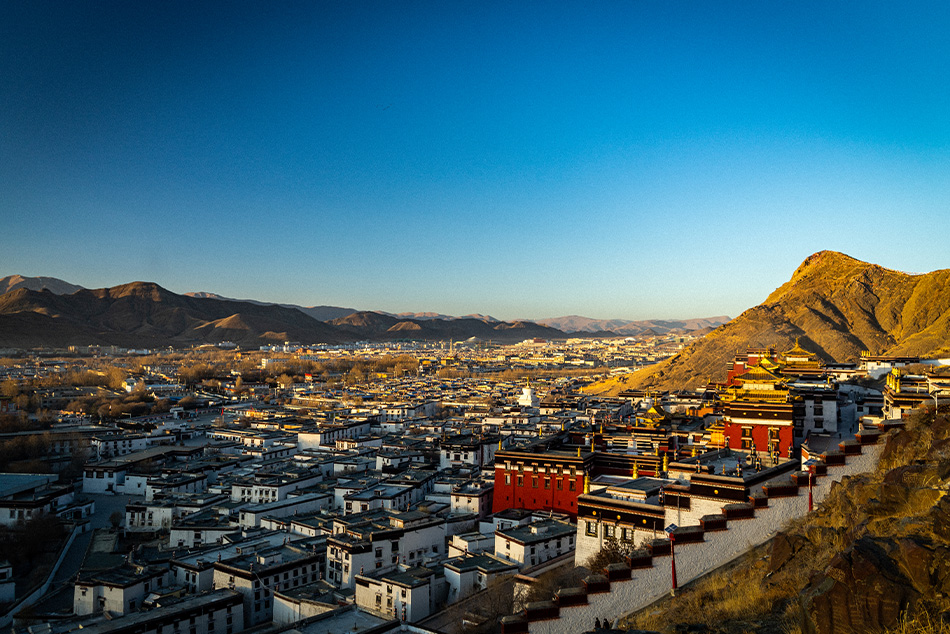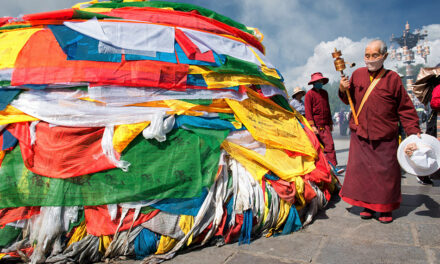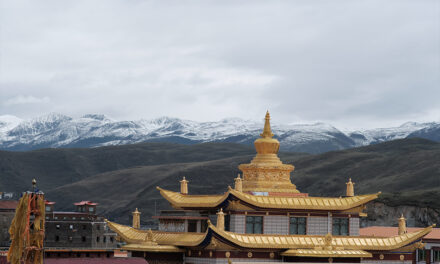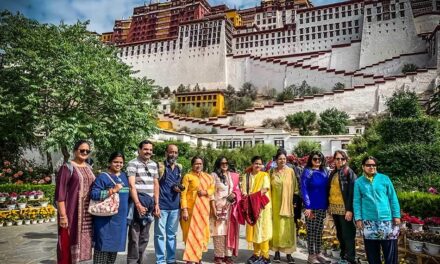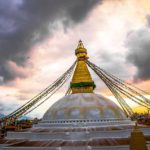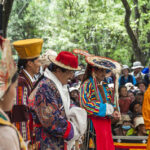How to Prepare Your Tour to Tibet. Tibet, often referred to as the “Roof of the World,” is an extraordinary land that beckons travelers with its breathtaking natural beauty, deep-rooted culture, and profound spirituality. Nestled in the heart of the Himalayas, this region offers a unique and soul-stirring travel experience that transcends mere tourism.
Imagine a land where towering snow-capped peaks touch the sky, where pristine lakes glisten like sapphires, and where vast, untouched expanses of wilderness stretch as far as the eye can see. Tibet is a place of unparalleled natural beauty, a realm of high plateaus, rugged terrains, and serene landscapes that have inspired countless adventurers, explorers, and seekers of enlightenment for centuries.
But Tibet is not just about awe-inspiring landscapes; it’s a place where ancient traditions and spirituality intermingle with daily life. The rich Tibetan culture, rooted in Buddhist practices and deeply spiritual beliefs, is a cornerstone of this remarkable land. Monasteries and temples stand as testaments to the enduring faith of its people, and the resonance of sacred chants fills the air, creating an atmosphere of deep serenity and introspection.
Traveling to Tibet is more than a mere journey; it’s an opportunity to immerse yourself in a world where the modern pace of life has not eroded the ancient traditions and values. The Tibetan people, known for their warm hospitality, welcome visitors with open hearts, offering a glimpse into their way of life and the centuries-old customs they hold dear.
To make the most of your journey to Tibet, careful consideration and preparation are essential. The region’s unique geography, high altitude, and travel restrictions require a thoughtful approach. In this comprehensive guide, we will provide you with the necessary steps to ensure your Tibet tour is not only memorable but also safe and enjoyable. From gathering essential documents to selecting the perfect tour, deciding on your mode of travel, packing wisely, and delving deeper into the local culture, our guide will be your compass on this extraordinary adventure.
Embark on this voyage to the “Roof of the World,” and let Tibet’s natural splendor, cultural richness, and spiritual depth captivate your senses and enrich your soul.
Step 1: Gather Essential Documents
Passport
Your passport is your gateway to the mystical land of Tibet. It is the first and most vital document you’ll need to ensure a smooth and unforgettable journey. Let’s delve deeper into the essential passport requirements that will pave the way for your Tibet adventure.
Passport Validity: To embark on your journey, your passport must be valid for at least six months from the date your tour commences. This requirement ensures that you can complete your planned itinerary without any hassles or interruptions. It’s essential to check your passport’s expiration date well in advance of your trip and renew it if necessary.
Blank Pages: While you review your passport’s validity, don’t forget to consider the number of blank pages. Many countries, including China, require travelers to have a certain number of unused pages in their passport for visas and permits. It’s advisable to have at least two to four blank pages to accommodate the necessary stamps, especially if you plan to visit other countries before or after China.
Tibet’s extraordinary landscapes, ancient monasteries, and vibrant culture await you. With a valid passport and sufficient blank pages, you’ll be well-prepared to embark on your remarkable journey to the “Roof of the World.”
Chinese Visa
Your journey to Tibet involves navigating the intricacies of Chinese visas and, if you choose to travel through Nepal, securing a special Chinese group visa. Here’s a detailed look at what you need to know:
The necessity of a Chinese visa depends on your nationality and the route you plan to take. Some fortunate travelers from countries like Singapore, Japan, Belarus, Mauritius, and more can enjoy visa-free travel to Tibet for a limited duration. However, for many travelers, obtaining a Chinese visa is essential.
Application in Your Home Country:
If you need a Chinese visa, it’s best to apply for it in your home country. This is often the most straightforward way to acquire the necessary documentation. Ensure that you submit your visa application well in advance of your planned departure to Tibet. It’s recommended to apply for a tourist visa (L visa) and avoid listing Tibet as one of your destinations in your application. Mentioning Tibet can complicate the visa issuance process, so it’s best to focus on Chinese cities as your destinations. If require we at i tibet travel & tours can help send you visa invitation to help smoothing your visa process.
Nepalese Embassy Requirements:
If your journey involves traveling through Nepal, you will need a different type of visa – the special Chinese group visa. This unique visa requirement stems from the fact that you will be entering Tibet from Nepal.
Visit the Nepalese Embassy:
To obtain the special Chinese group visa, you’ll need hire a Visa Agent in Kathmandu, All travel agency in Tibet has their trusted visa partners in Nepal. Kathmandu Embassy will not entertain individual applicant. This Visa Agent’s staff will guide you through the application process and provide you with the specific requirements. Your travel agency in Tibet will prepared your Visa Invitation and will send it to Visa agent. to present your travel itinerary, passport details, and other relevant documents. Processing times for this visa may vary, so it’s advisable to consult the embassy well in advance to ensure a smooth transition into Tibet.
Understanding and fulfilling these visa requirements is crucial in ensuring a seamless and hassle-free entry into Tibet. Whether you’re opting for a Chinese visa in your home country or securing the unique Chinese group visa through the Nepalese Embassy, proper planning will pave the way for your unforgettable Tibetan adventure.
Tibet Travel Permits: Unlocking the Gate to Tibet
When venturing into the mesmerizing world of Tibet, obtaining the essential Tibet travel permit is your key to unlock the gate to this extraordinary destination. Here’s a closer look at what these permits entail and how to secure them:
Mandatory Tibet Travel Permit:
Before you set foot in Tibet, it’s crucial to understand that you must obtain a Tibet travel permit. This permit serves as your authorization to enter and explore this remarkable region. Tibet’s unique tourism policy necessitate this additional layer of documentation.
Expert Assistance from Your Chosen Travel Agency:
Navigating the intricate process of obtaining Tibet Travel Permits is where your chosen travel agency becomes your indispensable ally. Their local knowledge and expertise are invaluable in ensuring you acquire the necessary permits without any complications.
Timely Submission of Documents:
To initiate the permit acquisition process, you’ll need to provide your travel agency with clear copies of your passport and visa. The agency will handle the paperwork and liaise with the relevant authorities on your behalf. It’s advisable to submit these documents at least 20 days before your intended departure to ensure ample processing time. Your travel agency will guide you through this process, making it as seamless as possible.
Ready for Your Adventure:
Once your travel agency has successfully obtained the permits, they will be in possession of all the necessary documentation for your Tibet tour. These permits are not mere pieces of paper; they are your tickets to explore a land of mystique and beauty.
Seamless Air Travel:
If your journey to Tibet involves air travel, the permits will be sent to the city from which you are departing. I would personally recommend you to transit your flight in Chengdu to ensure permit delivery on time. This ensures that you have your permits in hand when you board your flight to Lhasa. It’s a meticulous process orchestrated to make your arrival in Tibet as smooth as the journey itself.
Securing your Tibet travel permits is a vital step in your travel preparations. These permits not only grant you access to the mesmerizing landscapes and rich culture of Tibet but also ensure that you are in compliance with local regulations. By entrusting this process to your travel agency, you are setting the stage for an adventure of a lifetime, where the beauty and mystique of Tibet await your exploration.
Step 2: Select Your Perfect Tibet Tour Package
Tibet, with its diverse landscapes, cultural treasures, and spiritual depths, offers a plethora of tour options to cater to a wide range of traveler preferences. Whether you’re seeking an intimate and customizable experience or an adventure with fellow explorers, Tibet has something to offer. Here, we present your choices to ensure your tour aligns perfectly with your travel aspirations:
Private Tours: Your Personal Odyssey in Tibet
Private tours to Tibet are the epitome of flexibility and customization, offering a truly tailor-made experience that caters to your unique desires and preferences. Let’s delve deeper into the exceptional advantages of embarking on a private tour:
Personalized Itinerary:
When you opt for a private tour, you take the reins of your journey. It’s like having a blank canvas where you can paint the picture of your ideal Tibetan adventure. Every element of your itinerary is crafted to suit your interests, whether it’s exploring ancient monasteries, trekking through high mountain passes, or immersing yourself in the local culture.
Choose Your Duration:
How long do you want your Tibetan odyssey to last? With a private tour, you decide. Whether you have a week, a month, or more to spare, your itinerary is meticulously designed to fit your preferred duration. No need to rush; take your time and savor every moment.
Hotel Selection:
Your accommodation is another aspect of your journey that can be tailored to your liking. Choose from a range of hotels, from luxury options to more budget-friendly establishments, based on your comfort and budget requirements. You can select accommodations that resonate with your personal style, whether it’s a cozy boutique guesthouse or a high-end resort.
Set Your Pace:
Are you an avid adventurer, eager to explore every corner of Tibet, or do you prefer a leisurely exploration, taking your time to soak in the scenery? The pace of your journey is entirely in your hands. You can linger at an awe-inspiring viewpoint, savor a cup of local yak butter tea, or immerse yourself in deep conversations with the locals. Your private tour ensures that you dictate the tempo.
Freedom to Choose Attractions:
With a private tour, you have the liberty to curate your own list of attractions. If there are specific monasteries, lakes, or cultural experiences that intrigue you, they can be woven into your itinerary. You can also decide how much time you want to spend at each location, allowing you to delve deeper into the places that captivate your heart.
Finally, Your private tour of Tibet is a canvas on which you can paint the travel experience of your dreams. It offers the freedom to explore this mesmerizing land on your terms, ensuring that every moment is a reflection of your individual aspirations and curiosity. Whether you seek adventure, cultural immersion, or spiritual discovery, a private tour of Tibet can transform your vision of this mystical region into a reality.
Tibet Group Tours: Embrace the Spirit of Exploration with Like-Minded Travelers
Group tours to Tibet offer a remarkable opportunity to embark on a shared adventure, where you’ll connect with fellow explorers who share your passion for discovery. Here’s an in-depth look at the distinctive features and benefits of choosing a group tour:
Itineraries Designed for Variety:
Group tours are meticulously crafted to cater to diverse interests. These itineraries often draw inspiration from the feedback and experiences of previous travelers, ensuring a comprehensive exploration of Tibet’s cultural and natural wonders. You’ll follow a thoughtfully planned route that takes you through the most captivating destinations in the region.
Small Group Dynamics:
Group tours are typically composed of a small number of participants, usually no more than 10 people. This smaller group size fosters a more intimate and cohesive atmosphere, allowing for easier interactions and camaraderie among fellow travelers. As you journey through Tibet, you’ll have the opportunity to connect with like-minded individuals who share your curiosity and enthusiasm.
Cost-Effective Exploration:
One of the key advantages of group tours is their cost-effectiveness. Shared expenses, such as transportation and guide fees, result in a more budget-friendly option for exploring Tibet. This makes group tours an attractive choice for travelers who seek an enriching experience without breaking the bank.
Expert Guidance:
Throughout your group tour, you’ll benefit from the knowledge and expertise of local guides who are well-versed in the intricacies of Tibet. These guides serve as invaluable sources of information, providing insights into the history, culture, and spirituality of the region. They enhance your journey by offering a deeper understanding of the places you visit.
Shared Experiences:
The shared adventure of a group tour creates lasting memories and connections. Whether you’re marveling at the grandeur of Tibetan monasteries, exploring vibrant local markets, or taking in the awe-inspiring natural landscapes, you’ll have the opportunity to share your experiences and thoughts with your fellow travelers. It’s a journey of shared wonder and discovery. With is own drawback like health and wellness of member will effect the tour of the rest of the group member.
Group tours to Tibet are an exceptional way to experience the region’s wonders while forging new connections with people who share your love for exploration. The shared spirit of adventure, cost-effective travel, and expert guidance make group tours an attractive choice for those seeking a comprehensive and enriching experience in the captivating land of Tibet.
Tibet Trekking Tours: Embark on a Journey into Tibet’s Untouched Wilderness
Trekking tours in Tibet offer a unique and immersive way to experience the pristine natural beauty of this enchanting land. These tours take you off the beaten path and allow you to trace the historic routes used by nomadic Tibetans for centuries. Let’s explore the captivating world of trekking in Tibet:
Unveiling Hidden Beauty:
When you embark on a trekking tour in Tibet, you step into a world where nature reigns supreme. The routes you traverse reveal hidden gems of Tibet’s natural beauty – from soaring peaks and tranquil lakes to lush valleys and untamed wilderness. Each day brings new vistas, offering a sense of discovery and awe.
Nomadic Heritage:
Tibet’s nomadic culture is deeply intertwined with the land. Trekking allows you to follow in the footsteps of the nomads who once roamed these high plateaus in search of grazing pastures for their herds. The trails you traverse are imbued with the history and traditions of these resilient people.
Flexibility in Exploration:
One of the standout features of trekking tours is their flexibility. Itineraries are designed to be adaptable, giving you the freedom to adjust routes and durations to match your preferred pace. Whether you’re a seasoned trekker or new to the experience, you can choose a trekking route that suits your comfort level and the depth of exploration you desire.
Connecting with Nature:
Trekking in Tibet offers a profound connection with the natural world. You’ll breathe in the crisp mountain air, listen to the soothing rush of fast-flowing rivers, and immerse yourself in the serenity of remote landscapes. As you walk the trails, you’ll feel a deep connection with the earth beneath your feet and the skies above.
Cultural Encounters:
Along your trekking routes, you may encounter remote Tibetan villages and engage with the local communities. These interactions provide a unique opportunity to learn about the culture and way of life of the people who call these highlands home. From sharing traditional meals to participating in local customs, your trekking experience becomes enriched by these cultural encounters.
Trekking tours in Tibet are not just physical journeys; they are immersive experiences that engage all your senses and deepen your appreciation for the natural world. As you follow historic paths, surrounded by breathtaking vistas and the echoes of nomadic history, you’ll forge a profound connection with this mesmerizing land. Tibet’s untouched wilderness is waiting to be explored, and trekking tours offer the perfect avenue to discover the region’s hidden treasures.
Step 3: Decide How to Travel to Tibet
By Air: The Swiftest Path to Tibet’s Heart
Embarking on a journey to Tibet by air is the quickest and most widely chosen option for travelers seeking to explore this captivating region. Here, we explore the seamless process of flying to Tibet, which promises you a memorable and hassle-free experience:
Lhasa, Your Gateway:
Lhasa, the mesmerizing capital of Tibet, is the primary entry point for travelers arriving by air. This city, nestled in the heart of the Himalayas, is well-connected with major Chinese cities, ensuring convenient access to Tibet’s breathtaking landscapes and rich cultural heritage.
Tibet Travel Permit:
Before you can board a plane to Lhasa, you must secure your Tibet Travel Permit. This essential document is obtained with the assistance of your trusted travel agency. Your travel agency will handle the permit application process, ensuring that you meet all the necessary requirements and have the permit ready for your journey. This permit will serve as your ticket to enter Tibet, allowing you to experience its wonders firsthand.
Connecting to Lhasa:
Once your Tibet Travel Permit is secured, you’ll be all set to board your flight. Note that flights to Lhasa are available year-round, and you can choose from a range of departure cities in China. Whether you’re departing from Beijing, Chengdu, or Shanghai, there are multiple daily flights connecting you to the captivating world of Tibet.
International Connection to Kathmandu:
In addition to domestic flights, there is one international flight linking Lhasa, Tibet, and Kathmandu, Nepal. This unique route offers an intriguing option for travelers looking to combine their Tibetan adventure with a visit to Nepal. However, it’s important to note that this route requires a special group visa. Be sure to make the necessary arrangements through your travel agency to ensure a smooth transition from Nepal to Tibet.
Welcoming You at Lhasa:
Upon arriving at the Gonggar airport in Lhasa, you’ll be greeted by the awe-inspiring vistas of the Tibetan plateau. Keep an eye out for your guide, who will be holding a sign with your name, ensuring a warm welcome to Tibet with offering of white Khata, Tibetan White scarf.
Flying to Tibet is not just about reaching a destination; it’s about embarking on an adventure that begins the moment you step aboard your flight. The breathtaking landscapes below, the anticipation of exploring a land shrouded in mystique, and the warmth of Tibetan hospitality are all part of this remarkable journey. Tibet, the “Roof of the World,” beckons you, and by air, you’ll reach its heart with speed and convenience, setting the stage for an unforgettable travel experience.
By Train: An Epic Journey Through the Tibetan Plateau
Choosing to reach Tibet by train is an extraordinary adventure that promises a unique and unforgettable experience. Here, we explore the fascinating world of train travel to Tibet, where breathtaking views of the Tibetan plateau await:
A Scenic Expedition:
Train travel to Tibet is more than just a mode of transportation; it’s an expedition into the heart of the Tibetan plateau. The journey offers breathtaking views of the rugged landscapes, expansive plateaus, and majestic peaks that define this enchanting region. As you peer out of your train window, you’ll be treated to an ever-changing landscape that leaves a lasting impression on your soul.
Departures from Multiple Cities:
Trains to Tibet run from several major Chinese cities, offering travelers a range of departure points. Whether you choose to board the train in Chengdu, Xi’an, Beijing, or another city, the journey promises to be an adventure from the moment you step aboard.
Varying Levels of Comfort:
Train options cater to different levels of comfort. Travelers can choose from various classes, each offering a unique level of service and amenities. While some may opt for more luxurious accommodations, others may seek the charm of sleeper cars that provide a cozy and communal experience.
The Length of the Journey:
Train travel to Tibet is not a swift endeavor; the journey may take up to 40 hours, depending on your departure point. However, this extended travel time is an opportunity to savor the stunning scenery and immerse yourself in the experience of traversing the Tibetan plateau. The slow pace of the train allows you to appreciate the rugged terrain, the serene vistas, and the grandeur of the high mountains.
An Adventure Worth Taking:
While train travel to Tibet may be a longer route compared to flying, the scenic rewards make it an adventure worth embarking on. The immersive experience of this journey is unparalleled, allowing you to connect with the soul-stirring landscapes and the profound spirituality that define Tibet.
Traveling to Tibet by train is not merely a means of reaching your destination; it’s a voyage that offers a deeper connection with the land, its people, and its natural beauty. The epic train journey through the Tibetan plateau is an exploration of a world where time seems to stand still, and the allure of Tibet’s grandeur unfolds before your very eyes.
Overland Routes: The Roads Less Traveled to Tibet
Venturing into Tibet through overland routes presents a unique opportunity to immerse yourself in the rich landscapes and diverse cultures that span this extraordinary region. Here’s a closer look at the overland routes connecting Tibet with China, Nepal, and India:
Nepal – Everest and Friendship Highway:
Travelers seeking a remarkable Himalayan adventure can journey to Tibet from Nepal via the awe-inspiring Everest and Friendship Highway. This iconic route takes you through the heart of the Himalayas, offering incredible vistas of towering peaks and remote mountain villages. As you traverse this legendary highway, you’ll have the chance to witness the grandeur of Mount Everest and immerse yourself in the unique cultures that define this border region. The journey is an odyssey of natural beauty and spiritual discovery.
China – Routes from Chengdu and Xining:
Another set of popular overland routes to Tibet begins in China. From the bustling metropolis of Chengdu to the serene landscapes of Xining, these routes offer a diverse range of experiences. Travelers can choose to embark on a journey from Chengdu, exploring the lush Sichuan province before reaching the Tibetan plateau. Alternatively, you can begin your adventure from Xining, a city nestled on the eastern edge of the plateau. These routes provide a distinctive perspective on Tibet, allowing you to transition gradually from the heart of China to the awe-inspiring Tibetan landscapes.
Overland routes to Tibet are not just a means of reaching your destination; they are a transformative journey that unravels the diversity and beauty of the Tibetan plateau and its surrounding regions. As you traverse these roads less traveled, you’ll have the opportunity to connect with local communities, witness breathtaking natural wonders, and experience the rich tapestry of cultures that define this mesmerizing land. Each route is a gateway to a new adventure, and the landscapes you encounter along the way will leave an indelible mark on your heart.
Pack Wisely
As you prepare for your journey to Tibet, paying careful attention to your luggage is essential to ensure a smooth and comfortable travel experience. Here’s a closer look at the important luggage considerations that will make your expedition to the “Roof of the World” more convenient and enjoyable:
- Trekking Tour Weight Limits: If you’re planning to embark on a trekking tour in Tibet, it’s crucial to be mindful of weight restrictions. In the remote and rugged terrains you’ll be exploring, porters typically have weight limits for the gear they can carry, which often hovers around 8-10 kg. This restriction is in place to ensure the safety and well-being of the local staff who assist in transporting equipment. Therefore, pack thoughtfully, bringing only what is absolutely necessary for your trek.
- Airline Luggage Allowances: Different airlines may have varying luggage allowances for both international and domestic flights. Be sure to check the specific regulations and limits for the airline you are flying with. Pay close attention to weight restrictions, as well as the dimensions of your checked and carry-on luggage. Being aware of these details will help you avoid any unexpected fees or inconveniences at the airport.
- Space for Souvenirs: When traveling to Tibet, it’s almost inevitable that you’ll be captivated by the array of unique souvenirs and cultural treasures you encounter along the way. To accommodate these mementos, consider leaving some extra space in your luggage. Having room for souvenirs not only allows you to bring a piece of Tibet’s rich culture back home but also supports local artisans and markets.
- Practical Packing: To make the most of your luggage space, adopt practical packing strategies. Rolling your clothes instead of folding them can save space and minimize wrinkles. Utilize packing cubes to keep your belongings organized and easily accessible. Be sure to pack essentials like clothing layers suitable for the diverse Tibetan climate, comfortable footwear for trekking or walking, and any specific gear required for your chosen activities.
- Prepared for Varying Climates: Tibet’s climate can vary greatly depending on the region and time of year. As you pack, consider the weather conditions you’ll encounter during your journey. Layering is key to adapting to the changing temperatures, from chilly mountain mornings to warmer afternoons in the valleys. Additionally, packing a sturdy rain jacket or windbreaker is advisable to be prepared for unexpected weather changes.
By keeping these luggage considerations in mind, you’ll be well-prepared for your Tibetan adventure. Thoughtful packing ensures that you are equipped to navigate the diverse landscapes and cultures of Tibet, all while embracing the opportunity to bring a piece of this remarkable land back home with you in the form of cherished souvenirs and cherished memories.
Clothing and Gear Suggestions: Dressing Smart for Tibet’s Diversity
Tibet’s diverse landscapes and varying altitudes demand thoughtful consideration when it comes to packing clothing and gear for your journey. Here are some valuable suggestions to ensure that you’re well-equipped to embrace Tibet’s ever-changing weather and captivating experiences:
- Layered Clothing: Tibet’s climate is marked by its unpredictability, with temperatures that can fluctuate significantly throughout the day. As a result, packing layered clothing is a wise choice. Begin with a moisture-wicking base layer to keep you dry and comfortable. On top of this, add insulating layers to trap warmth when needed. A waterproof and windproof outer layer is essential to shield you from unexpected rain or gusty winds. This adaptable approach to dressing ensures that you’re prepared for any weather that Tibet might present.
- Sturdy Walking Shoes: Exploring Tibet often involves trekking, hiking, and walking on a variety of terrains. Sturdy, comfortable walking shoes or hiking boots with good traction are essential for your comfort and safety. Opt for footwear that provides support and protection for your feet, as you traverse a range of landscapes, from mountain trails to ancient city streets.
- First-Aid Kit: It’s advisable to carry a basic first-aid kit that includes items like adhesive bandages, antiseptic wipes, pain relievers, and any personal medications you require. High-altitude locations may cause symptoms of altitude sickness in some individuals, so consider including altitude sickness medication in your kit. Having these essentials on hand ensures that you can address minor injuries or ailments during your journey.
- Sun Protection: Tibet’s high-altitude terrain exposes you to intense sunlight, making sun protection a priority. Pack sunscreen with a high SPF rating to shield your skin from the sun’s powerful rays. Don’t forget to bring sunglasses and a wide-brimmed hat to protect your eyes and face. These items are invaluable for maintaining your comfort and well-being, particularly during outdoor activities.
- Reusable Water Bottle: Staying hydrated is crucial when traveling in Tibet, especially at high altitudes. Carry a reusable water bottle to have a convenient and eco-friendly way to access clean drinking water. You can refill your bottle at your accommodations, ensuring that you stay well-hydrated throughout your journey.
Incorporating these clothing and gear suggestions into your packing list ensures that you’re well-prepared to navigate the diverse landscapes and ever-changing weather of Tibet. With the right attire and essentials at your disposal, you’ll be ready to fully embrace the rich culture, natural beauty, and adventurous activities that Tibet has to offer.
Step 5: Learn More About Tibet – Deepening Your Connection to the Land of Enchantment
As you prepare for your journey to Tibet, the final step is not just a logistical one; it’s a cultural and spiritual invitation. Delve into the rich tapestry of Tibet’s customs, religion, art, culture, and the extraordinary people who call this land their home. This knowledge is the key to unlocking a deeper connection with the region, enhancing your travel experience, and allowing you to fully immerse yourself in the local culture. Here’s why this step is a vital one:
- Understanding Customs: Familiarizing yourself with Tibetan customs is a gesture of respect and goodwill. Knowing the appropriate way to greet locals, showing reverence at religious sites, and understanding social etiquette can enrich your interactions and help you feel like an honored guest rather than a mere tourist.
- Exploring Religion: Tibetan Buddhism is deeply woven into the fabric of everyday life in Tibet. Learning about the beliefs, rituals, and practices of this faith will allow you to engage more profoundly with the culture. Visiting monasteries and stupas will hold more meaning as you grasp the spiritual significance they hold for the Tibetan people.
- Embracing Art and Culture: Tibet boasts a rich artistic heritage, including intricate thangka paintings, vibrant tapestries, and masterful sculptures. Understanding the symbolism and history behind these art forms deepens your appreciation of their beauty. Additionally, familiarizing yourself with traditional Tibetan music, dance, and cuisine offers insights into the region’s vibrant cultural identity.
- Connecting with People: Tibetans are known for their warm and welcoming nature. Learning a few basic Tibetan phrases or greetings can go a long way in forging connections with locals. It’s a small effort that can result in unforgettable interactions and friendships.
By investing time in learning about Tibet’s customs, religion, art, culture, and people, you’ll embark on your journey with a deeper sense of reverence and wonder. You won’t merely be a spectator; you’ll become a participant in the extraordinary story of Tibet. As you explore this enchanting land, your knowledge will bridge the gap between you and the local communities, fostering a more meaningful and unforgettable travel experience.
Conclusion of How to Prepare Your Tour to Tibet
Preparing for your tour to Tibet requires careful planning and attention to detail. With the right documents, tour selection, travel method, and packing, you can ensure a smooth and memorable journey in this captivating region. Remember to embrace the rich culture and stunning landscapes Tibet has to offer.
FAQs on How to Prepare Your Tour to Tibet
Is it necessary to obtain a Chinese visa for a Tibet tour?
Whether you need to obtain a Chinese visa for a Tibet tour depends on your nationality and your travel route. Here are the key points to consider:
Visa-Free Travel:
Some travelers from select countries, such as Singapore, Japan, Belarus, Mauritius, and more, can enjoy visa-free travel to Tibet for a limited time. If you are a citizen of one of these countries and your stay in Tibet falls within the specified visa-free duration, you may not need a Chinese visa.
Chinese Visa Requirement:
If you do not fall under the visa-free category or if your travel route includes stops in other parts of China before reaching Tibet, you will likely need a Chinese visa. It’s essential to check the specific visa requirements based on your nationality and travel plans.
Avoid Listing Tibet:
When applying for a Chinese visa, it’s advisable not to list Tibet as one of your destinations. Including Tibet on your visa application can complicate the process, as it is considered a sensitive area. Instead, you can list some of the Chinese cities you plan to visit before entering Tibet.
Nepalese Embassy Requirements:
If you intend to travel through Nepal to reach Tibet, you will need a special type of visa known as a Chinese group visa. This visa can be obtained at the Nepalese Embassy. It’s important to review the specific requirements and processing times for this visa, as it differs from the standard Chinese visa.
To ensure you have the correct visa for your Tibet tour, it is recommended to work with a reliable travel agency that specializes in Tibet tours. They can provide guidance and assistance in obtaining the necessary permits and visas based on your travel plans and nationality.
What are the advantages of choosing a private tour over a group tour in Tibet?
Choosing between a private tour and a group tour in Tibet depends on your preferences and travel style. Both options have their advantages, so let’s explore the benefits of selecting a private tour:
- Flexibility: One of the most significant advantages of a private tour is the flexibility it offers. You have the freedom to customize your itinerary, select the duration of your stay, choose your preferred hotels, and set the pace of your journey. You can decide which attractions to visit and how much time to spend at each, tailoring the experience to your interests and preferences.
- Personalized Experience: With a private tour, the entire itinerary revolves around you and your travel companions. Your guide can provide personalized attention, catering to your specific interests and ensuring that you get the most out of your Tibet experience. You can ask questions, make requests, and explore at your own pace.
- Exclusive Access: Private tours often provide access to unique and off-the-beaten-path destinations that may not be included in group tours. This exclusivity allows you to explore hidden gems and enjoy a more intimate connection with the local culture and landscapes.
- Privacy and Comfort: If you value privacy and comfort, a private tour is an excellent choice. You won’t need to share transportation or accommodations with strangers, and you can enjoy a more peaceful and comfortable travel experience.
- Tailored Accommodations: In a private tour, you can select the level of accommodations that suit your preferences and budget, whether it’s luxury hotels or cozy boutique guesthouses. You have the flexibility to choose the type of lodging that enhances your travel experience.
- Seamless Planning: Private tours are meticulously planned, with attention to every detail. Your travel agency will take care of permits, logistics, and any special requests you may have, ensuring a seamless and hassle-free journey.
- Personalized Itineraries: Private tours allow you to explore your own interests and passions. Whether you’re an avid photographer, a history enthusiast, or a nature lover, your itinerary can be crafted to align with your hobbies and interests.
- Travel Companions: You have the option to travel with your chosen companions, whether it’s a partner, family, or a small group of friends. This ensures that you share the experience with those closest to you.
However, it’s important to note that private tours are often more expensive than group tours, as you are covering the costs of personalized services and exclusive experiences. Group tours, on the other hand, offer a more budget-friendly option and the chance to meet like-minded travelers.
Ultimately, the choice between a private tour and a group tour in Tibet comes down to your travel preferences, budget, and the type of experience you seek.
Are there any specific health precautions to take when traveling to Tibet?
Traveling to Tibet, particularly due to its high-altitude terrain, requires special health precautions to ensure your well-being during your journey. Here are some key health considerations:
- Altitude Sickness: Tibet’s high altitudes can lead to altitude sickness, which can affect travelers at elevations over 8,000 feet (2,400 meters). To minimize the risk:
- Consider arriving in Lhasa (Tibet’s capital) a few days before embarking on strenuous activities to acclimatize.
- Stay well-hydrated and avoid alcohol and strenuous exercise in the initial days.
- If symptoms of altitude sickness (headache, nausea, dizziness) occur, it’s essential to rest and consult a healthcare professional. Medications for altitude sickness are also available.
- Vaccinations: Ensure your routine vaccinations are up to date. It’s recommended to consult a healthcare professional for travel vaccinations such as hepatitis A and B, typhoid, and diphtheria. Discuss with your doctor the need for vaccinations based on your specific itinerary and health.
- Water and Food Safety: Avoid consuming tap water and uncooked or unpeeled fruits and vegetables. Stick to bottled water or water that has been properly purified. Eat cooked and hot meals from reputable sources to reduce the risk of foodborne illnesses.
- Sun Protection: Tibet’s high altitudes mean stronger UV radiation. Protect yourself from sunburn by wearing sunscreen with a high SPF, sunglasses, and a wide-brimmed hat. It’s advisable to bring lip balm with sunblock to protect your lips as well.
- Medical Supplies: Carry a basic medical kit that includes essentials like adhesive bandages, antiseptic wipes, pain relievers, and any personal medications you require. Consider including altitude sickness medication if your itinerary involves ascending to high altitudes.
- Travel Insurance: It’s highly recommended to have comprehensive travel insurance that covers medical emergencies and evacuations, as well as trip cancellations or delays. Ensure that your policy is suitable for high-altitude travel.
- Hydration: Staying well-hydrated is crucial, especially at high altitudes. Drink plenty of fluids to prevent dehydration, which can exacerbate altitude sickness symptoms.
- Respect Local Customs: When visiting monasteries and other religious sites, follow local customs, including appropriate dress and behavior. This shows respect for the culture and ensures a positive travel experience.
- Consult a Healthcare Professional: Before your trip, consult a healthcare professional who specializes in travel medicine. They can provide personalized recommendations and advice based on your health and travel plans.
Remember that Tibet’s remote and high-altitude areas may have limited access to medical facilities, so it’s crucial to prioritize your health and safety throughout your journey. Being well-prepared and informed will help ensure a memorable and enriching experience in this extraordinary region.
How do I adjust to the high altitude in Tibet?
Adjusting to high altitude in Tibet is essential for your health and comfort during your journey. Tibet’s average elevation is over 13,000 feet (4,000 meters), which can lead to altitude sickness or acute mountain sickness (AMS) for some travelers. Here are some tips to help you acclimatize effectively:
- Arrive in Lhasa First: If possible, begin your journey in Lhasa, the capital of Tibet, as it’s at a lower altitude than many other destinations in the region. Spend a few days in Lhasa before ascending to higher altitudes to acclimatize gradually.
- Hydrate: Staying well-hydrated is crucial at high altitudes. Drink plenty of water throughout the day to prevent dehydration, which can worsen AMS symptoms. Avoid excessive alcohol and caffeine, as they can contribute to dehydration.
- Avoid Overexertion: In the first few days at high altitudes, limit physical exertion and strenuous activities. Allow your body time to adapt to the reduced oxygen levels. Rest when needed, and don’t push yourself too hard.
- Eat Lightly: During the initial days at high altitudes, consume smaller and lighter meals. This eases the digestive process, as your metabolism can slow down at altitude.
- Altitude Sickness Medication: Consult with a healthcare professional before your trip to discuss medications for altitude sickness. Acetazolamide (Diamox) is a common prescription medication that can help prevent and alleviate AMS symptoms. It’s essential to follow your doctor’s recommendations regarding dosage.
- Local Remedies: Tibetan herbal teas or remedies, such as ginger tea, are sometimes used to alleviate altitude sickness symptoms. Consult with your guide or local experts for recommendations.
- Breathing Exercises: Deep and slow breathing can help increase oxygen intake. Practice breathing exercises when you feel short of breath, but avoid hyperventilation.
- Coca Leaves: In some high-altitude regions, such as parts of Peru, chewing coca leaves is a traditional remedy for altitude sickness. However, this may not be readily available in Tibet, so consult with local experts for alternatives.
- Descend if Necessary: If you experience severe altitude sickness symptoms, such as severe headaches, vomiting, or confusion, it’s essential to descend to lower altitudes immediately. Don’t delay in seeking medical attention if your symptoms worsen.
- Consult a Healthcare Professional: Before your trip, consult a healthcare professional who specializes in travel medicine. They can provide personalized recommendations and advice based on your health and travel plans.
Remember that everyone’s body reacts differently to high altitude, and it’s not always possible to predict who will experience altitude sickness. Therefore, it’s essential to be vigilant, prioritize your health, and adjust your activities and travel plans accordingly. With proper acclimatization, you can make the most of your visit to Tibet without compromising your well-being.
What is the best time of year to visit Tibet for pleasant weather and fewer crowds?
The best time to visit Tibet for pleasant weather and fewer crowds is during the spring and autumn months. Here are the two primary recommended seasons for a Tibet visit:
- Spring (April to June): Spring is considered one of the most pleasant times to visit Tibet. The weather is mild, with daytime temperatures ranging from 50°F to 68°F (10°C to 20°C) in many parts of Tibet. This season offers beautiful scenery, as the landscape comes to life with blossoming flowers and lush greenery. It’s an ideal time for trekking and outdoor activities. Keep in mind that this is also a popular time for tourists, so it’s advisable to book accommodations and permits in advance.
- Autumn (September to November): Another fantastic time to visit Tibet is during the autumn months. The weather is generally stable, and you’ll experience clear skies and pleasant daytime temperatures ranging from 50°F to 68°F (10°C to 20°C). Autumn is ideal for trekking, as the landscape is adorned with vibrant colors, especially in October. Crowds are thinner compared to the peak summer months, making it a more peaceful and enjoyable experience.
The main reason to choose these seasons is the comfortable weather and stunning scenery. During spring and autumn, you can explore Tibet’s natural beauty and cultural heritage without the extremes of winter cold or the rainy season.
Avoiding the summer and winter extremes is advisable for most travelers. Summer (June to August) brings warmer temperatures but also the monsoon season, which can lead to rain and the possibility of landslides in some areas. Winter (December to February) is extremely cold, with temperatures dropping well below freezing, making travel challenging and some areas inaccessible.
Ultimately, the best time for your Tibet journey depends on your preferences, but spring and autumn offer the most favorable weather and lower crowds, providing an ideal balance for a memorable and comfortable visit.

